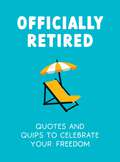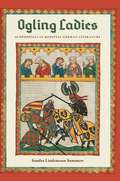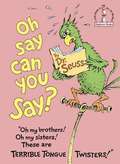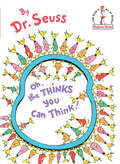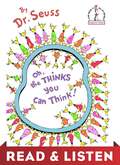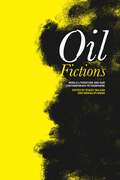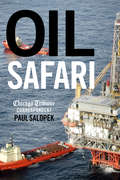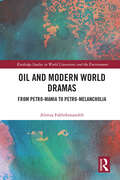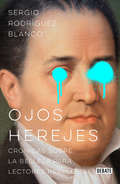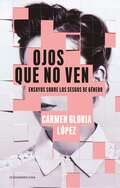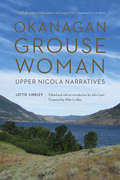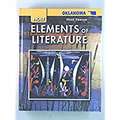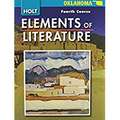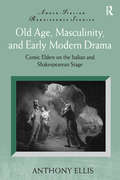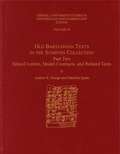- Table View
- List View
Officially Retired: Hilarious Quips and Quotes to Celebrate Your Freedom
by Ted HeybridgeCongratulations, you've retired! It's time to celebrate your freedom. Make the most of all your new free time with Officially Retired, a funny book of quotes, quips and statements on the joys and tribulations of retirement. Put your feet up, relax and enjoy this side-splitting little book.
Ogling Ladies: Scopophilia in Medieval German Literature
by Sandra Lindemann SummersIn the European Middle Ages, the harm a person’s gaze could cause was greatly feared. A stare was considered an act of aggression; intense gazing was believed to exert immense power over the individual observed. The love of looking, or scopophilia, is a common motif among female figures in medieval art and literature where it is usually expressed as a motherly or sexually interested gaze--one sanctioned, the other forbidden. Sandra Summers investigates these two major variants of female voyeurism in exemplary didactic and courtly literature by medieval German authors. Setting the motif against the period’s dominant patriarchal ethos and its almost exclusive pattern of male authorship, Summers argues that the maternal gaze was endorsed as a stabilizing influence while the erotic gaze was condemned as a threat to medieval order. Summers examines whether medieval artists and writers invented the idea of “ogling,” or whether they were simply recording a behavioral practice common at the time. She investigates how the act of ogling altered the narrative trajectory of female characters, and she also considers how it may have affected the regulation and restriction of women during Europe’s Middle Ages. Drawing upon contemporary gender studies, women’s studies, film studies, and psychology, Summers argues that the female gaze ultimately governs social formation. The exploration of the female gaze in period literature transcends medieval scholarship and impacts our understanding of the broader problem of gender perceptions and social structuring in Western civilization.
Oh, the Thinks You Can Think! (Beginner Books(R))
by Dr. SeussThe possibilities are endless in the board edition of this classic Dr. Seuss Beginner Book --the perfect back-to-school read for a new year! Young readers will delight in this Oh, the Thinks You Can Think! which celebrates the imagination and encourages young readers to think . . . about thinking! &“Think left and think right and think low and think high. Oh, the Thinks you can think up if only you try.&”Originally created by Dr. Seuss himself, Beginner Books are fun, funny, and easy to read. These unjacketed hardcover early readers encourage children to read all on their own, using simple words and illustrations. Smaller than the classic large format Seuss picture books like The Lorax and Oh, The Places You&’ll Go!, these portable packages are perfect for practicing readers ages 3-7—and lucky parents too!
Oh, the Thinks You Can Think! Read & Listen Edition (Beginner Books(R))
by Dr. SeussThe possibilities are endless in Dr. Seuss&’s classic Beginner Book! Young readers will delight in Oh, the Thinks You Can Think! which celebrates the imagination and encourages young readers to think . . . about thinking! &“Think left and think right and think low and think high. Oh, the Thinks you can think up if only you try.&”Originally created by Dr. Seuss, Beginner Books encourage children to read all by themselves, with simple words and illustrations that give clues to their meaning.This Read & Listen edition contains audio narration.
Ohio Holt Elements of Literature, Second Course
by Kylene Beers Carol Jago Deborah ApplemanNIMAC-sourced textbook
Oil Fictions: World Literature and Our Contemporary Petrosphere (AnthropoScene)
by Stacey Balkan and Swaralipi NandiOil, like other fossil fuels, permeates every aspect of human existence. Yet it has been largely ignored by cultural critics, especially in the context of the Global South. Seeking to make visible not only the pervasiveness of oil in society and culture but also its power, Oil Fictions stages a critical intervention that aligns with the broader goals of the energy humanities.Exploring literature and film about petroleum as a genre of world literature, Oil Fictions focuses on the ubiquity of oil as well as the cultural response to petroleum in postcolonial states. The chapters engage with African, South American, South Asian, Iranian, and transnational petrofictions and cover topics such as the relationship of colonialism to the fossil fuel economy, issues of gender in the Thermocene epoch, and discussions of migration, precarious labor, and the petro-diaspora. This unique exploration includes testimonies of the oil encounter—through memoirs, journals, and interviews—from a diverse geopolitical grid, ranging from the Permian Basin to the Persian Gulf.By engaging with non-Western literary responses to petroleum in a concentrated, sustained way, this pathbreaking book illuminates the transnational dimensions of the discourse on oil. It will appeal to scholars and students working in literature and science studies, energy humanities, ecocriticism, petrocriticism, environmental humanities, and Anthropocene studies.In addition to the editors, the contributors to this volume include Henry Obi Ajumeze, Rebecca Babcock, Ashley Dawson, Sharae Deckard, Scott DeVries, Kristen Figgins, Amitav Ghosh, Corbin Hiday, Helen Kapstein, Micheal Angelo Rumore, Simon Ryle, Sheena Stief, Imre Szeman, Maya Vinai, and Wendy W. Walters.
Oil Safari
by Paul F. SalopekWould Americans pay more attention to their sources of petroleum-the lifeblood of their car-centric society-if gasoline came with a price tag tallying the explicit human costs of each fill-up? What untold stories of war, poverty and corruption get burned up and expelled from millions of U.S. tailpipes every day? And do false industry assurances that fuel can never be traced from local service stations back to its origins in troubled foreign oil patches help absolve us of responsibility for the wages of our energy addiction?Two-time Pulitzer Prize-winning journalist Paul F. Salopek, a Chicago Tribune foreign correspondent, tackles these questions that are at the heart of Oil Safari: In Search of the Source of America's Fuel. Taken from Salopek's four-part narrative travelogue published in 2006, this book debunks the well-tended industry myth that global oil flows are too complex and fungible to tease apart at a retail outlet.Salopek describes the gripping stories of a diverse cast of characters who are touched by a typical shipment of oil that ends up in the U.S. There is the oil rig worker in the Gulf of Mexico, an Iraqi security consultant, a Nigerian fisherman whose homeland is threatened by drilling, and an indigenous Venezuelan elder who benefits from the country's oil reserves (which are used to fund social programs).Energy policy is at the heart of American politics now more than ever, between the troubling aftermath of the BP Deepwater Horizon oil spill, the burgeoning American surplus of natural gas, and the Obama administration's continued emphasis on renewable energy sources. Oil Safari brings human narratives to the foreground of our energy policy debates and own personal consumption habits.
Oil and Modern World Dramas: From Petro-Mania to Petro-Melancholia (Routledge Studies in World Literatures and the Environment)
by Alireza FakhrkonandehThe first to focus on the (re-)presentations of oil in dramatic literature, theatre, and performance, Oil and Modern World Dramas is a pioneering volume in the emerging field of Oil Literatures and Cultures, and the more established field of World Literatures. Through close analysis, Fakhrkonandeh demonstrates how these dramatic works depict oil, both in its perceived nature and character, as an overdetermined matter/sign/object: a symbol (of freedom, autonomy, speed, wealth, modernity, enlightenment), a commodity, a social-cultural agent, a social relation, and a hyper-object. This book is also distinguished by its innovative and critically manifold conceptual framework, positing the petro-literatures and petro-cultures an inextricable part of a global network. Oil and Modern World Dramas not only demonstrates how the chosen works of petro-drama manifest these concepts in their social-political vision, aesthetics and historical-ontological dynamics, but also reveals how they deploy such assemblage-based approaches both as a cartographical means and aesthetic method for exposing the systemic (Capitalocenic) nature of petro-capitalist exploitation, and as means of proposing ways of resistance and producing alternative modes of subjectivity, community, relationality, and economy.
Oil and Modern World Dramas: From Petro-Mania to Petro-Melancholia (Routledge Studies in World Literatures and the Environment)
by Alireza FakhrkonandehThe first to focus on the (re-)presentations of oil in dramatic literature, theatre, and performance, Oil and Modern World Dramas is a pioneering volume in the emerging field of Oil Literatures and Cultures, and the more established field of World Literatures. Through close analysis, Fakhrkonandeh demonstrates how these dramatic works depict oil, both in its perceived nature and character, as an overdetermined matter/sign/object: a symbol (of freedom, autonomy, speed, wealth, modernity, enlightenment), a commodity, a social-cultural agent, a social relation, and a hyper-object. This book is also distinguished by its innovative and critically manifold conceptual framework, positing the petro-literatures and petro-cultures an inextricable part of a global network. Oil and Modern World Dramas not only demonstrates how the chosen works of petro-drama manifest these concepts in their social-political vision, aesthetics and historical-ontological dynamics, but also reveals how they deploy such assemblage-based approaches both as a cartographical means and aesthetic method for exposing the systemic (Capitalocenic) nature of petro-capitalist exploitation, and as means of proposing ways of resistance and producing alternative modes of subjectivity, community, relationality, and economy.
Ojos herejes: Crónicas sobre la belleza para lectores rebeldes
by Sergio Rodríguez BlancoEn catorce crónicas, que son también ensayos sobre literatura y arte desde o sobre México, Ojos herejes examina los procesos intelectuales de la creación y cuestiona la momentánea fe que nos exige el arte. El itinerario de Sergio Rodríguez Blanco nos recuerda a las mejores páginas de sus dos modelos del viajero intelectual: el José Vasconcelos del Ulises criollo y el Sergio Pitol de El arte de la fuga. El autor nació en España, pero desde hace años habita en México en un mundo fluido: sale a caminar por el centro de la Ciudad de México y de pronto lo acompañamos a una lección de arte contemporáneo en la bienal de Venecia. Nos revela los secretos de la casona que inspiró El amor en tiempos del cólera de García Márquez y luego, con Pedro Friedeberg, nos descubre la dimensión artística del papel higiénico. Desentraña el misterio de una película que Federico Fellini jamás rodó (pero que derivó en un delirante viaje por México) y páginas después, con el escritor italiano Pino Cacucci, Sergio comprende que volver a México es una forma más de reiniciar el viaje. -Del prólogo de Oswaldo Zavala "El ojo, si es hereje, puede traspasar el velo de los discursos dominantes, los estereotipos, las cegueras y ensoñaciones que hemos naturalizado." -Del capítulo El polvo y el gorila
Ojos que no ven
by Carmen Gloria LópezA partir de una serie de podcast sobre la realidad de la mujer en Chile y el mundo, la autora construye un ensayo de textos híbridos, mezcla de crónica y guion, en el que reflexiona sobre las deudas, el futuro, la imagen social y el poder de las féminas hoy. Textos híbridos que apuntan a reflexionar sobre la realidad de la mujer hoy y la visión que la sociedad tiene sobre su rol en el mundo, apelando a una mirada feminista y analítica, tanto de las redes sociales, la publicidad, la dimensión laboral e íntima, tópicos que han cambiado velozmente en la última década.
Okanagan Grouse Woman: Upper Nicola Narratives
by Lottie LindleyPublished through the Recovering Languages and Literacies of the Americas initiative, supported by the Andrew W. Mellon FoundationIn this book of Native American language research and oral traditions, linguist John Lyon collects Salish stories as told by culture-bearer Lottie Lindley, one of the last Okanagan elders whose formative years of language learning were unbroken by the colonizing influence of English. Speaking in the Upper Nicola dialect of Okanagan, a Southern Interior Salish language, Lindley tells the stories that recount and reflect Salish culture, history, and historical consciousness (including names of locales won in battle with other interior peoples), coming-of-age rituals and marriage rites, and tales that attest to the self-understanding of the Salish people within their own history. For each Okanagan Salish story, Lyon and Lindley offer a continuous transcription followed by a collaborative English translation of the story and an interlinear rendition with morphological analysis. The presentation allows students of the dialect, linguists, and those interested in Pacific Northwest and Interior Plateau indigenous oral traditions unencumbered access to the culture, history, and language of the Salish peoples. With few native speakers left in the community, Okanagan Grouse Woman contributes to the preservation, presentation, and—with hope—maintenance and cultivation of a vital indigenous language and the cultural traditions of the Interior Salish peoples.
Oklahoma Common Core Coach, English Language Arts, Grade 4
by Triumph LearningNIMAC-sourced textbook
Oklahoma Holt Elements of Literature: Fifth Course, Essentials of American Literature
by Kylene Beers Lee OdellHigh school literature textbook.
Oklahoma Holt Elements of Literature: Fourth Course, Essentials of American Literature
by Kylene Beers Lee OdellNIMAC-sourced textbook
Oklahoma Holt Elements of Literature: Introductory Course
by Kylene Beers Lee OdellNIMAC-sourced textbook
Oklahoma Holt Elements of Literature: Second Course
by Kylene Beers Lee OdellNIMAC-sourced textbook
Oklahoma Holt Elements of Literature: Sixth Course, Essentials of British and World Literature
by Kylene Beers Lee OdellTextbook.
Oklahoma McDougal Littell Literature
by Mcdougal LittellAn 8th Grade literature and language arts textbook
Old Age, Masculinity, and Early Modern Drama: Comic Elders on the Italian and Shakespearean Stage (Anglo-Italian Renaissance Studies)
by Anthony EllisThis first book-length study to trace the evolution of the comic old man in Italian and English Renaissance comedy shows how English dramatists adopted and reimagined an Italian model to reflect native concerns about and attitudes toward growing old. Anthony Ellis provides an in-depth study of the comic old man in the erudite comedy of sixteenth-century Florence; the character's parallel development in early modern Venice, including the commedia dell'arte; and, along with a consideration of Anglo-Italian intertextuality, the character's subsequent flourishing on the Elizabethan and Jacobean stage. In outlining the character's development, Ellis identifies and describes the physical and behavioral characteristics of the comic old man and situates these traits within early modern society by considering prevailing medical theories, sexual myths, and intergenerational conflict over political and economic circumstances. The plays examined include Italian dramas by Bernardo Dovizi da Bibbiena, Niccolò Machiavelli, Donato Giannotti, Lorenzino de' Medici, Andrea Calmo, and Flaminio Scala, and English works by William Shakespeare, Ben Jonson, and Thomas Dekker, along with Middleton, Rowley, and Heywood's The Old Law. Besides providing insight into stage representations of aging, this book illuminates how early modern people conceived of and responded to the experience of growing old and its social, economic, and physical challenges.
Old Babylonian Texts in the Schøyen Collection, Part Two: School Letters, Model Contracts, and Related Texts (CUSAS)
by A. R. George Gabriella SpadaIn ancient Mesopotamia, men training to be scribes copied model letters in order to practice writing and familiarize themselves with epistolary forms and expressions. Similarly, model contracts were used to teach them how to draw up agreements for the transactions typical of everyday economic life. This volume makes available a trove of previously unknown tablets and fragments, now housed in the Shøyen Collection, that were produced in the training of scribes in Old Babylonian schools.Following on Old Babylonian Texts in the Schøyen Collection, Part One: Selected Letters, this volume publishes the contents of sixty-five tablets bearing Akkadian letters used to train scribes and twenty-six prisms and tablets carrying Sumerian legal texts copied in the same context. Each text is presented in transliterated form and in translation, with appropriate commentary and annotations and, at the end of the book, photographs of the cuneiform. The material is made easily navigable by a catalogue, bibliography, and indexes.This collection of previously unknown documents expands the extant corpus of educational texts, making an essential contribution to the study of the ancient world.
